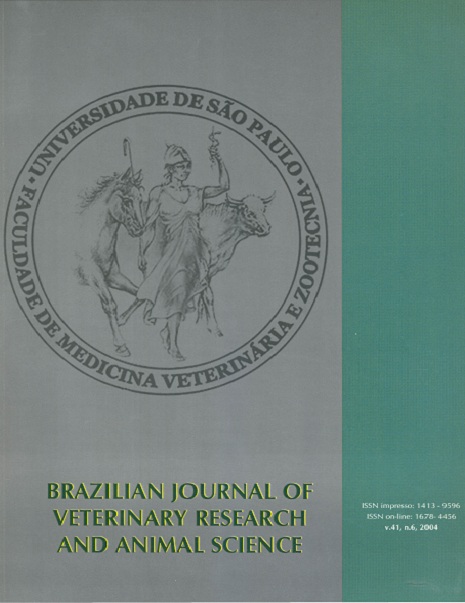Effect of some additives on the quality of elephant grass (Pennisetum purpureum, Schum) silage
DOI:
https://doi.org/10.1590/S1413-95962004000600009Keywords:
Silage, Fermentation, Digestibily, AdditivesAbstract
Twenty aditives were been used on ensiling Elephantgrass (80 days growing period): without additives (T1); 0.5% urea (T2); 10% cotton fiber (T3); 10% Elephantgrass hay (T4); 10% Guandu hay (T5); drying for 6 hours (T6); 2% suggar wastes (T7); 2% corn meal (T8); 4% corn meal (T9); 6% corn meal (T10); 2% corn meal and 0.5% urea (T11); 4% corn meal and 0.5% urea (T12); 6% corn meal and 0.5% urea (T13); 1% dried molasses (T14); 2% dried molases (T15); 3% dried molasses (T16); 1% dried molasses and 0.5% urea (T17); 2% dried molasses and 0.5% urea (T18); 3% dried molasses and 0.5% urea (T19); bacterial inoculant Biosilo (T20). pH was increased in T1 (5.36) and T5 (5.33). The other silages pH varied from 3.89 to 4.29 and were similar. The highest non protein nitrogen was observed in T3 and those which included urea, but this was not observed whem 3% of molasses was included. Most silage fermentations were towards lactic acid production and these results were similar. T2 and T3 showed higher butiric acid concentration than the others and T2 and T9 showed higher acetic acid production. In vitro dry matter digestibility coeficients were from 26.36 to 51.31%. Dry matter loss was higher on T2 (11.08%), T3 (10.50%) and T4 (9.8%).Downloads
Download data is not yet available.
Downloads
Published
2004-11-01
Issue
Section
UNDEFINIED
License
The journal content is authorized under the Creative Commons BY-NC-SA license (summary of the license: https://
How to Cite
1.
Andrade SJT de, Melotti L. Effect of some additives on the quality of elephant grass (Pennisetum purpureum, Schum) silage. Braz. J. Vet. Res. Anim. Sci. [Internet]. 2004 Nov. 1 [cited 2024 Dec. 25];41(6):409-15. Available from: https://revistas.usp.br/bjvras/article/view/6308





